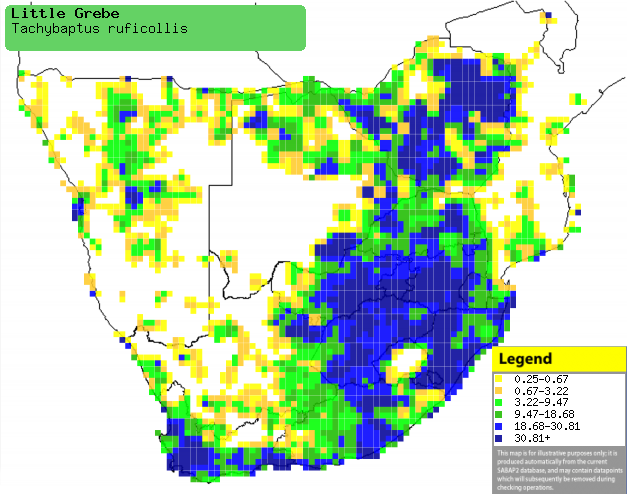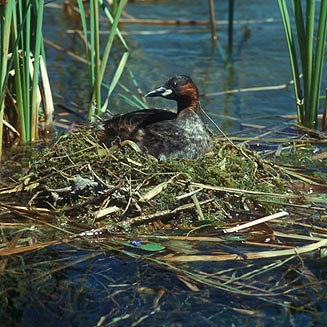|
Tachybaptus ruficollis (Little
grebe, Dabchick)
Kleindobbertjie [Afrikaans];
Unolwilwilwi, Unonyamembi [Xhosa]; Thoboloko [South Sotho]; Dodaars [Dutch];
Grèbe castagneux [French]; Zwergtaucher [German]; Mergulhão-pequeno
[Portuguese]
Life
> Eukaryotes >
Opisthokonta
> Metazoa (animals) >
Bilateria >
Deuterostomia > Chordata >
Craniata > Vertebrata (vertebrates) > Gnathostomata (jawed
vertebrates) > Teleostomi (teleost fish) > Osteichthyes (bony fish) > Class:
Sarcopterygii (lobe-finned
fish) > Stegocephalia (terrestrial
vertebrates) > Tetrapoda
(four-legged vertebrates) > Reptiliomorpha > Amniota >
Reptilia (reptiles) >
Romeriida > Diapsida > Archosauromorpha > Archosauria >
Dinosauria
(dinosaurs) > Saurischia > Theropoda (bipedal predatory dinosaurs) >
Coelurosauria > Maniraptora > Aves
(birds) > Order: Ciconiiformes > Family: Podicipedidae
Distribution and habitat
Occurs in Eurasia, the west Pacific islands, South-east
Asia and sub-Saharan Africa. In southern Africa, it is common to locally abundant across much of the region, largely
excluding the Kalahari. It generally prefers dams, lakes, small ponds, backwaters
in sluggish watercourses and temporary pans, occasionally moving away from fresh
water to saltpans and estuaries.
|
 |
|
Distribution of Little grebe in southern Africa,
based on statistical smoothing of the records from first SA Bird Atlas
Project (©
Animal Demography unit, University of
Cape Town; smoothing by Birgit Erni and Francesca Little). Colours range
from dark blue (most common) through to yellow (least common).
See here for the latest distribution
from the SABAP2. |
Predators and parasites
Movements and migrations
Generally resident, although it often moves
into seasonally flooded areas in the breeding season. It has an
uncanny ability to locate isolated oases, rapidly colonising new dams
in arid areas.
Food
It mainly eats fish and other aquatic animals, caught by
diving in stints of up to 50 seconds underwater. It often associates with ducks
and Hippopotamuses (Hippopotamus amphbius), catching the
aquatic life that they disturb. Like other grebes it sometimes eats its own feathers
as they act as a protective wrapping for fish bones, protecting the bird from
harm when it regurgitates pellets. The following food items have been recorded
in its diet:
- Vertebrates
- small fish
- frogs and tadpoles
- Invertebrates
- aquatic insects
- small crustaceans
- molluscs
Breeding
- Monogamous, territorial solitary nester, performing a variety of elaborate
courtship displays.
- The nest (see image below) is built by both sexes and maintained
throughout the incubation period, consisting of a floating platform of water
plants. This structure is usually anchored on a submerged plant in open water, or effectively
concealed among reeds.
 |
|
|
Little grebe on nest. [photo Peter Steyn
©] |
|
- Egg-laying season is year-round, peaking from August-February in Botswana
and the Western Cape, and from February-June elsewhere.
- It lays 2-9 eggs, which are incubated by both sexes for about 19-28
days.
- The chicks leave the nest within a few hours after hatching, after which
they join the adults to form a family group, regularly climbing onto a
parent's back to rest. At first, the adults feed them on a diet of tadpoles
and insect larvae, but after 29 days or so they are encouraged to try
foraging for themselves, which they can do competently a few days later.
They become fully independent at approximately 42 days old and are fully
grown eight days later.
Threats
Not threatened, in fact its population has increased
considerably due to the introduction of farm dams and other man-made
impoundments.
References
-
Hockey PAR, Dean WRJ and Ryan PG 2005. Roberts
- Birds of southern Africa, VIIth ed. The Trustees of the John Voelcker
Bird Book Fund, Cape Town.
|
